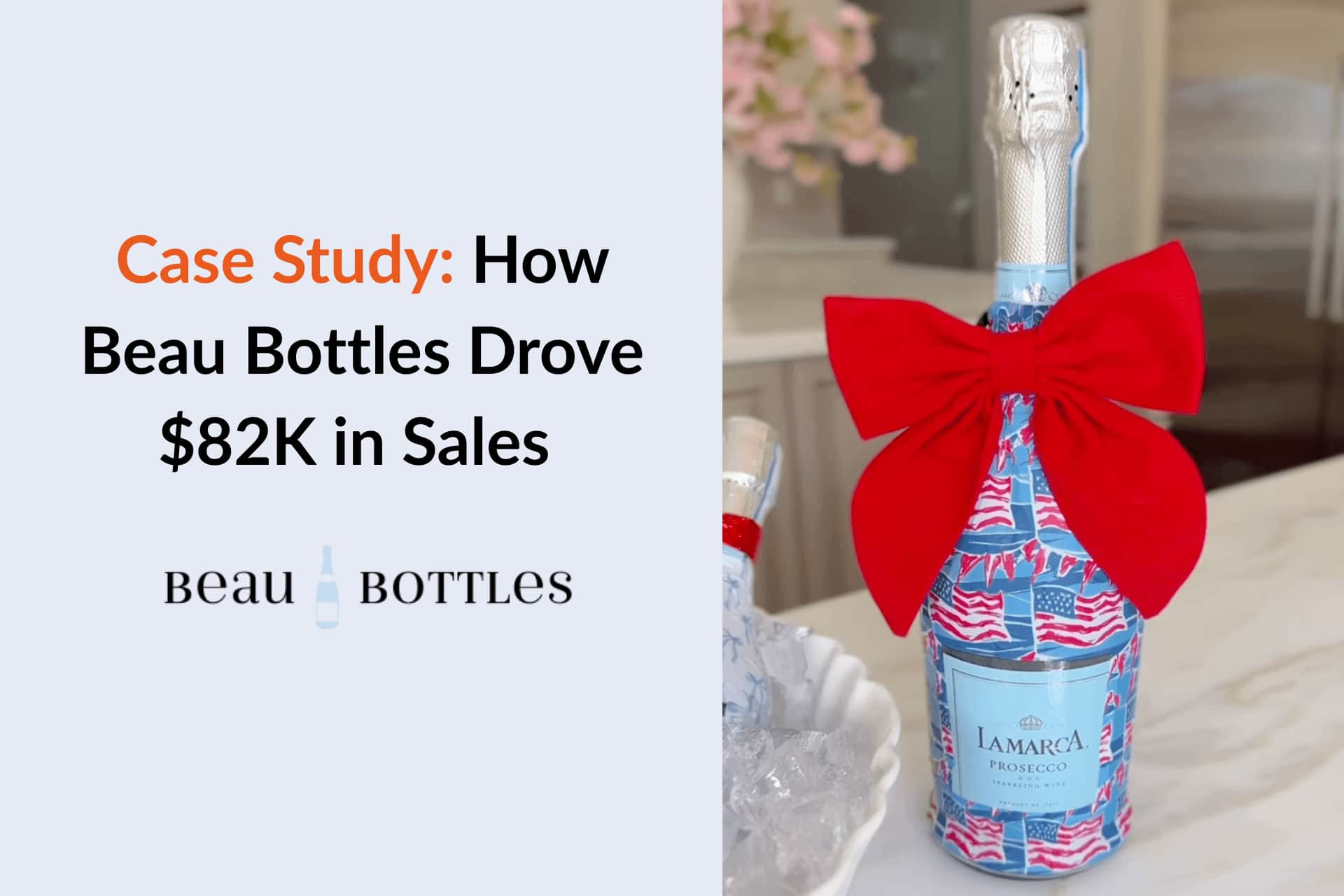





NoxInfluencer offers influencer discovery, analytics, competitor monitoring, and TikTok Shop integration. While it provides deep data and campaign management capabilities, some marketers encounter challenges such AS limited cross-platform automation, and a learning curve for navigating advanced modules. These factors have led brands to explore more flexible, scalable, and feature-rich alternatives.
In this article, we’ll examine the top NoxInfluencer alternatives, offering a detailed comparison of features, pricing, and usability to help brands identify the platform that best suits their influencer marketing objectives.
Top 10 Noxinfluencer Alternatives
1.Influencer Hero
2. Modash
3. Upfluence
4. Captiv8
5. CreatorIQ
6. HypeAuditor
7. GRIN
8. gen.video
9. Vyrill
10.Loox
While NoxInfluencer boasts one of the largest influencer databases on the market—claiming over 100 million profiles—the sheer size can be a double-edged sword. Many users find that the abundance of creators comes at the expense of quality, credibility, and efficient filtering, which can make campaign execution more challenging.
NoxInfluencer promotes its extensive coverage across YouTube, TikTok, Instagram, Twitch, and more. However, many of these profiles lack real influence or credible data, making it harder for brands to identify reliable collaborators.
Despite offering advanced analytics, the platform’s filtering tools are not strong enough to sift through millions of profiles effectively. This results in wasted time for marketers who must manually sort through irrelevant or low-quality influencers.
Some users report inconsistencies in the authenticity of listed influencers, with profiles showing inflated or unreliable metrics. Since many creators are not directly verified, brands risk working with influencers who deliver little to no real engagement.
With so many influencers available, NoxInfluencer leans heavily on quantity rather than quality. Brands seeking meaningful ROI may struggle, as the platform’s massive database doesn’t always translate into impactful, high-performing partnerships.
To compare the different platforms, we focused on central criteria that all must meet:

Platform Coverage: NoxInfluencer supports influencer marketing across YouTube, TikTok, Instagram, Facebook, and Twitch.
Best For: Brands, agencies, and enterprises that want a data-driven influencer marketing platform with powerful analytics, competitor monitoring, and influencer discovery at scale. Particularly useful for teams running multi-market or TikTok Shop-focused campaigns.
Pricing:
Reviews: 4.0/5.0 (G2).
Ease of Use (UX/UI): The platform provides a wide array of features (discovery, analytics, campaign management, outreach, and reporting) but some users find the layout overwhelming. The data depth is strong, but navigating across multiple modules may require a learning curve.
Customer Support: NoxInfluencer offers API support, campaign consulting, and customer service, but advanced assistance (like strategy advising and in-depth reports) is primarily tied to higher-tier or custom plans.
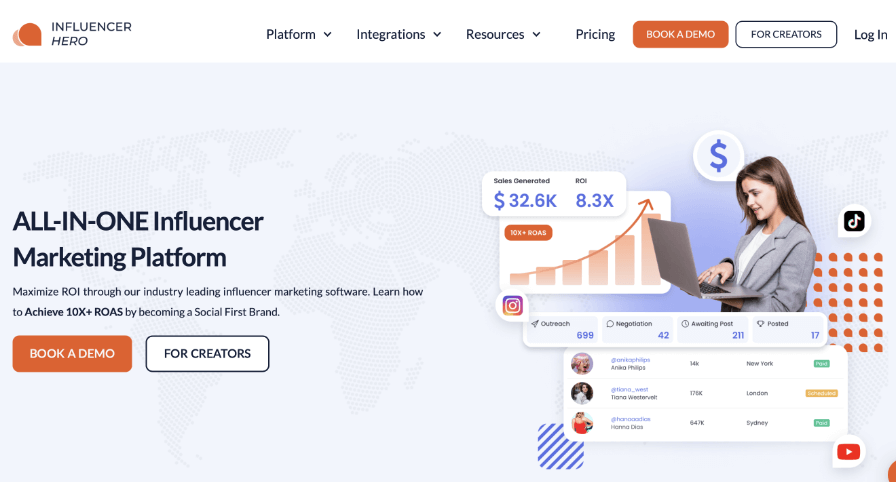
Platform Coverage: Influencer Hero supports influencer marketing across Instagram, TikTok, YouTube, Facebook, Pinterest, Snapchat, X (Twitter), and Twitch.
Best For: Influencer Hero is best for fast-scaling DTC brands and eCommerce businesses on Shopify, WooCommerce, or custom setups looking to run high-volume influencer, affiliate, and UGC campaigns from a single dashboard.
Pricing: Influencer Hero offers flexible monthly plans:
Reviews: 5.0 / 5.0 on Capterra
Ease of Use (UX/UI): The platform combines ready-made campaign templates with advanced customization. Small teams can launch quickly, while larger organizations can design complex workflows without losing clarity.
Customer Support: Every plan includes personalized support, and higher tiers offer Slack channels with dedicated managers. Help is available 24/7 via chat and email, backed by robust tutorials and documentation.
Influencer Hero supports Instagram, TikTok, YouTube, Facebook, Pinterest, Snapchat, X (Twitter), and Twitch, while Noxinfluencer focuses on YouTube, TikTok, Instagram, Facebook, and Twitch. Influencer Hero emphasizes high-volume influencer, affiliate, and UGC campaigns with automated workflows and eCommerce tracking, whereas Noxinfluencer excels at competitor monitoring and TikTok Shop-specific features.
Pricing for Influencer Hero ranges from $649/month for Standard (up to 1,000 creators), $1,049/month for Pro (up to 5,000 creators), and $2,490/month for Business (up to 10,000 creators), compared to Noxinfluencer’s Business plan at $1,499/quarter or $3,899/year, and Enterprise at $7,999/year. Influencer Hero offers more structured workflow automation and CRM for fast-scaling eCommerce brands, whereas Noxinfluencer provides deep analytics but requires more manual navigation.
Teams prioritizing centralized messaging, affiliate tracking, and reusable content libraries will benefit from Influencer Hero’s platform.
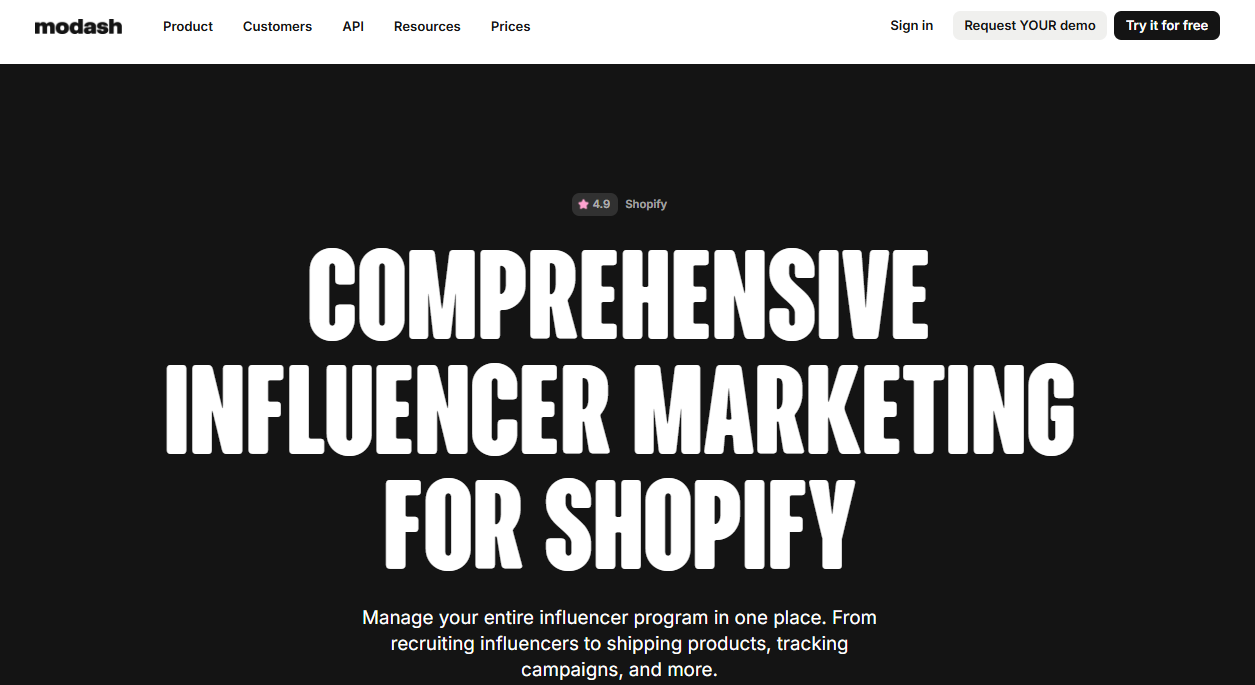
Platform coverage: Instagram, YouTube and TikTok. Limited functionality for influencers from Snapchat and X.
Pricing: Modash pricing starts at $199 per month. They also offer a medium tier plan fixed at a $499 rate. The enterprise level plan has custom pricing.
Reviews: 4.9/5.0 (Capterra)
Ease of Use (UX/UI): The interface is quick and intuitive, with responsive filters that adapt instantly. Teams can set up campaigns easily with minimal onboarding effort.
Customer Support: Email support is available to all, with live chat and faster responses on premium tiers. Tutorials and a detailed help center cover most user questions.
Modash focuses on Instagram, TikTok, and YouTube influencer discovery with audience verification and lookalike recommendations, while Noxinfluencer emphasizes a larger multi-platform database with TikTok Shop tools and competitor analytics. Modash supports rapid searches and real-time engagement tracking, whereas Noxinfluencer provides more extensive workflow and campaign management features.
Pricing for Modash starts at $199/month, with a mid-tier plan at $499/month, and enterprise custom plans, compared to Noxinfluencer’s $1,499/quarter Business plan and $3,899/year annual plan. Modash provides AI-powered follower verification and granular targeting for influencer vetting, while Noxinfluencer offers deep analytics, AI-assisted outreach, and API access for advanced teams.
Brands needing fast discovery and audience verification will find Modash effective. Noxinfluencer suits larger teams that require multi-market tracking, TikTok Shop integration, and comprehensive campaign management.

Platform coverage: Upfluence covers Instagram, TikTok, YouTube, X, Twitch, Pinterest, and WordPress blogs.
Pricing:
Reviews: 4.6/5.0 (G2)
Best For: E-commerce brands and agencies looking to scale YouTube influencer outreach and track ROI.
Ease of Use (UX/UI): The platform’s dashboard offers everything from influencer discovery to ROI tracking in one place. While highly functional, new users may face a learning curve during onboarding.
Customer Support: High-tier clients receive personal account managers and onboarding sessions. All users benefit from live chat and email support for quick resolutions.
Upfluence covers Instagram, TikTok, YouTube, X, Twitch, Pinterest, and WordPress blogs, offering cross-channel campaign management and affiliate tracking, while Noxinfluencer covers five major social platforms with strong competitor monitoring and TikTok Shop integration. Upfluence centralizes content, contracts, and analytics, whereas Noxinfluencer focuses on scalable workflow, AI automation, and API access.
Upfluence pricing starts at $399/month for gifting-only campaigns or $1,276/month for full access (annual billing), while Noxinfluencer’s Business plan is $1,499/quarter or $3,899/year, and Enterprise at $7,999/year. Upfluence excels in affiliate sales measurement and global payouts, whereas Noxinfluencer provides TikTok Shop tools, AI-driven influencer scoring, and customizable API data.
Brands seeking multi-channel affiliate campaigns and centralized content storage will favor Upfluence. Teams focused on deep analytics, TikTok Shop integration, and competitor insights will benefit more from Noxinfluencer.
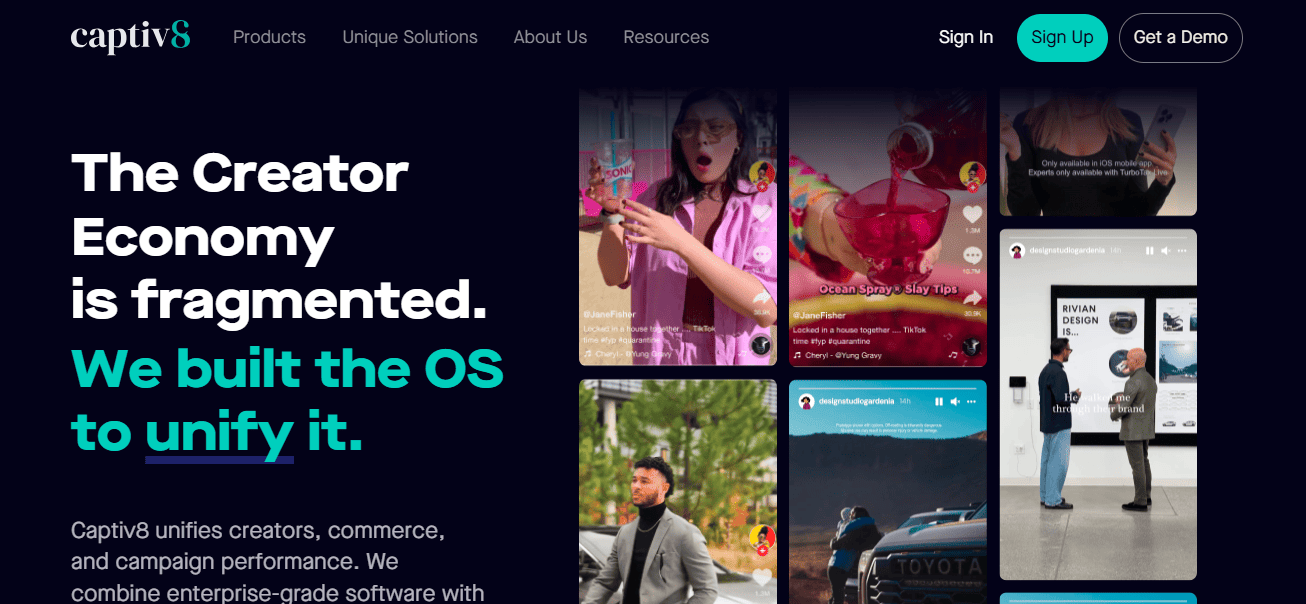
Platform coverage: Captiv8 covers Instagram, TikTok, Facebook, YouTube, X (formerly Twitter) and Twitch.
Pricing: $25.000 Annually (Annual commitment needed). Plus a $3.000 onboarding fee.
Reviews: 4.5/5.0 (G2)
Best for: Brands and agencies running large-scale influencer campaigns in platforms like Instagram, TikTok and YouTube.
Ease of Use (UX/UI): Advanced tools for experienced marketers; first-time users may need extra time to navigate. Multi-team collaboration and detailed analytics are supported.
Customer Support: Dedicated onboarding, campaign guidance, and account managers are available, though urgent issues may experience slower response times.
Captiv8 supports Instagram, TikTok, Facebook, YouTube, X, and Twitch, prioritizing AI-driven influencer matching and paid media amplification, whereas Noxinfluencer emphasizes multi-platform discovery, analytics, and TikTok Shop integrations. Captiv8’s advanced audience targeting and competitor analysis provide campaign insights, while Noxinfluencer offers AI-assisted outreach and API data flexibility.
Pricing for Captiv8 is $25,000 annually with a $3,000 onboarding fee, compared to Noxinfluencer’s $1,499/quarter or $3,899/year Business plan and $7,999/year Enterprise. Captiv8 is focused on large-scale campaigns and sophisticated targeting, while Noxinfluencer offers flexible plans for teams of all sizes with TikTok-specific tools.
Brands wanting AI influencer matching and paid media amplification will benefit from Captiv8. Noxinfluencer is preferable for teams prioritizing TikTok Shop sales, API access, and deep competitor analytics.
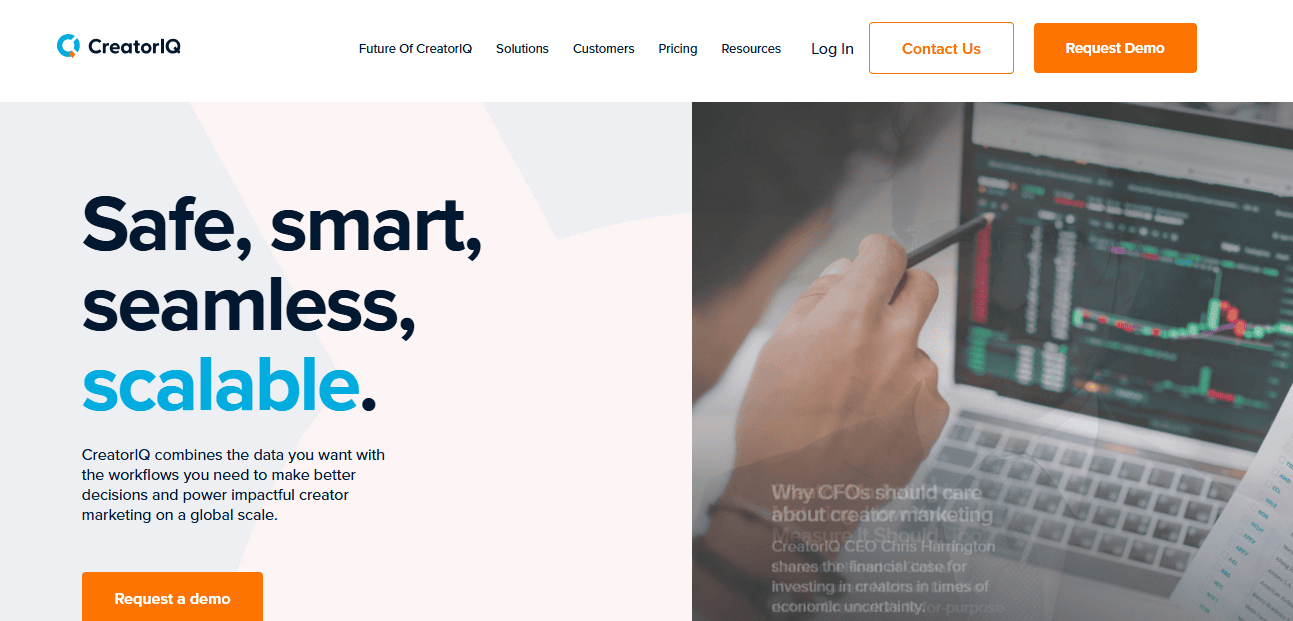
Platform Coverage: CreatorIQ supports Instagram, TikTok, YouTube, Facebook, Pinterest, Twitch, and X (Twitter).
Pricing: CreatorIQ pricing is divided into 4 tiers:
An optional “Creator Connect” feature available for an additional $15,000 per year
Reviews: 4.6/5.0 (G2)
Best For: Large-scale brands that require robust data controls, customizable workflows, and in-depth influencer analytics across international markets.
Ease of Use (UX/UI): CreatorIQ provides a polished interface tailored for enterprise teams managing multiple influencer programs simultaneously. While its workflow tools and automation options reduce repetitive setup, the sheer number of features can be overwhelming at first and requires time to fully understand.
Customer Support: Each client gets a dedicated account manager and ongoing strategy consultations. Global teams benefit from support that ensures campaigns consistently achieve performance and compliance goals.
CreatorIQ supports Instagram, TikTok, YouTube, Facebook, Pinterest, Twitch, and X, with enterprise-grade reporting, CRM, and compliance monitoring, whereas Noxinfluencer focuses on TikTok Shop, influencer discovery, and competitor analytics. CreatorIQ offers automated global workflows and deep integrations, while Noxinfluencer provides AI-powered outreach and flexible API data exports.
CreatorIQ pricing starts at $35,000/year for Basic, $50,000/year for Standard, $90,000/year for Professional, and $200,000/year for Enterprise, compared to Noxinfluencer’s Business plan at $1,499/quarter or $3,899/year and Enterprise at $7,999/year. CreatorIQ excels at enterprise-level multi-market campaigns, while Noxinfluencer provides scalable solutions with TikTok Shop-specific features for growing teams.
Brands needing advanced analytics, workflow automation, and compliance tools will benefit from CreatorIQ. Noxinfluencer is better suited for teams focusing on influencer discovery, TikTok commerce, and competitor benchmarking.
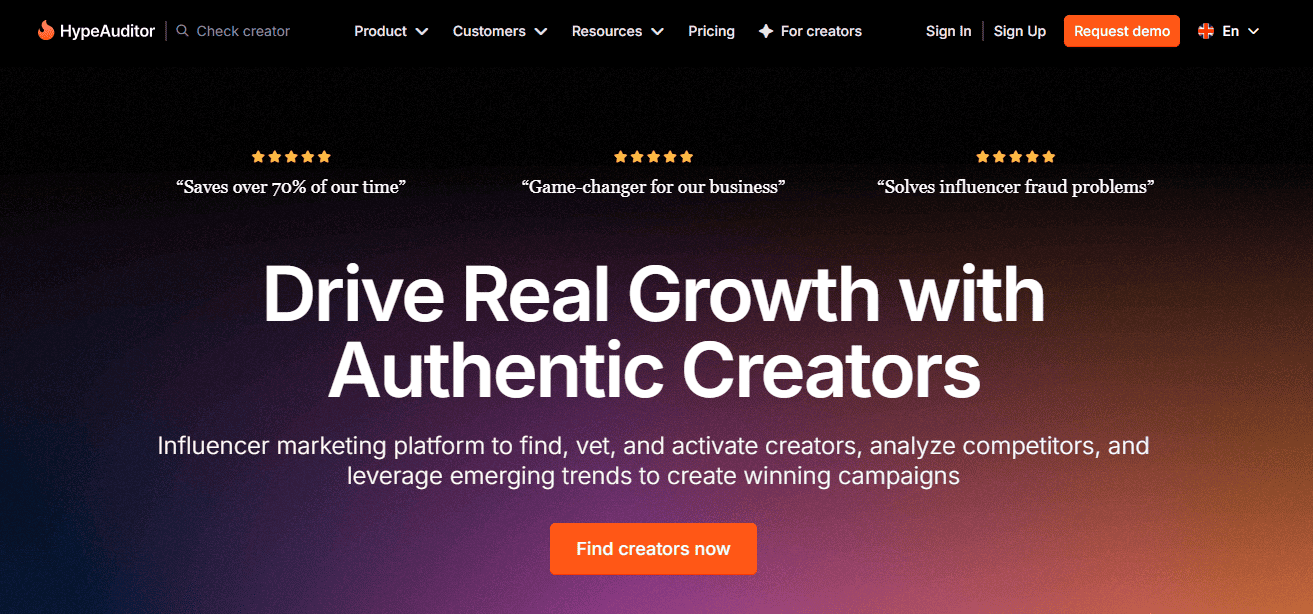
Platform Coverage: HypeAuditor supports Instagram, TikTok, YouTube, Twitch, X (Twitter), and Snapchat.
Pricing: Flexible usage-based pricing, with Business plans starting at around $10,000/year and Enterprise reaching up to $60,000/year.
Reviews: 4.6/5.0 (G2)
Best For: Teams that prioritize data accuracy, detecting fraudulent activity, and benchmarking competitors across various influencer platforms.
Ease of Use (UX/UI): A clean, metrics-focused interface allows teams to access detailed audience and influencer analytics quickly. Some advanced tools have a learning curve but provide in-depth insights once mastered.
Customer Support: Provides live chat, email, onboarding sessions, and an extensive knowledge base. Campaign setup and data analysis questions can be resolved efficiently with responsive support.
HypeAuditor specializes in fraud detection, follower verification, and competitive benchmarking on Instagram, TikTok, YouTube, Twitch, X, and Snapchat, whereas Noxinfluencer provides campaign management, TikTok Shop integration, and multi-platform discovery. HypeAuditor emphasizes analytics-driven insights, while Noxinfluencer offers automated outreach, API data, and competitor tracking.
Pricing for HypeAuditor starts around $10,000/year for Business and can reach $60,000/year for Enterprise, compared to Noxinfluencer’s Business at $1,499/quarter or $3,899/year, and Enterprise at $7,999/year. HypeAuditor excels at detecting bots and analyzing audience quality, whereas Noxinfluencer provides workflow automation and TikTok Shop campaign tools.
Brands prioritizing influencer data accuracy and competitive benchmarking will prefer HypeAuditor. Noxinfluencer is better for teams running campaigns at scale with eCommerce and TikTok Shop integrations.
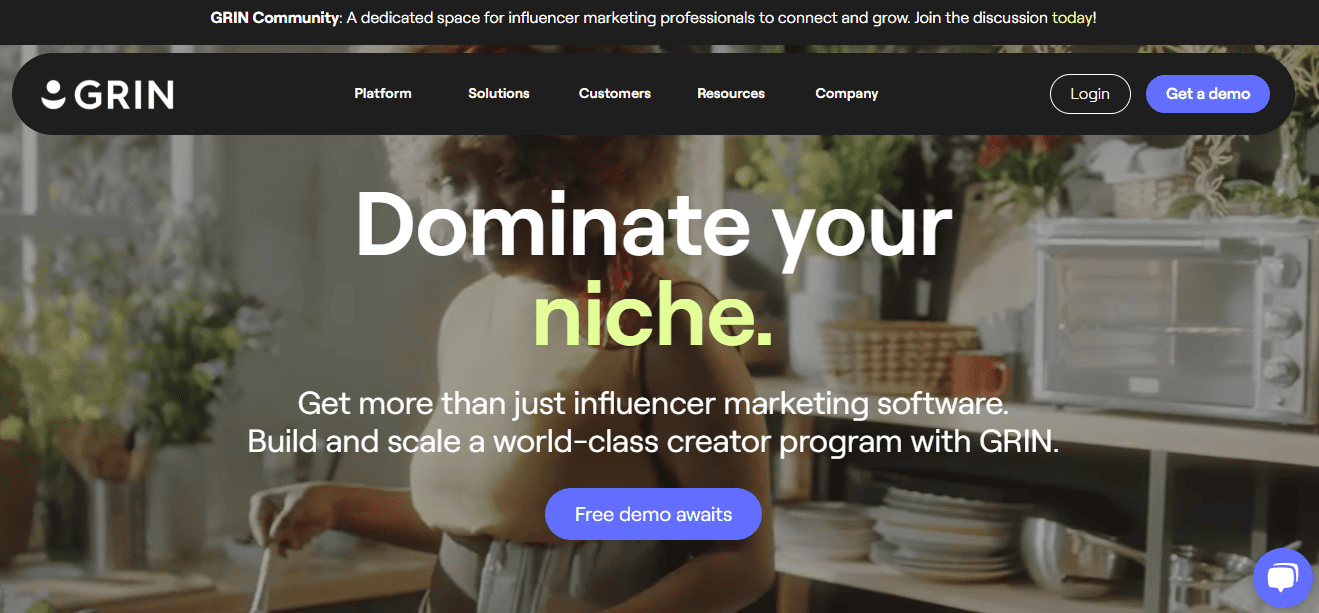
Platform Coverage: Instagram, TikTok, YouTube, X (formerly Twitter), Twitch, and Snapchat.
Pricing: GRIN’s yearly pricing starts at $25.000, with monthly payments available at $2.085/month. No discounts for upfront payments.
Best For: Best suited for DTC brands looking to centralize influencer relationship management in one streamlined system.
Reviews: 4.5/5.0 (G2)
Ease of Use (UX/UI): Intuitive dashboard simplifies campaign creation, though handling large influencer lists can slow performance. Batch actions are available but require care for efficiency.
Customer Support: Offers chat, email, and onboarding guidance, with dedicated strategists for premium plans. Support quality depends on subscription tier.
GRIN integrates with Instagram, TikTok, YouTube, X, Twitch, and Snapchat, focusing on influencer relationship management, affiliate tracking, and automated gifting, while Noxinfluencer emphasizes discovery, analytics, and TikTok Shop capabilities. GRIN provides CRM for long-term partnerships and streamlined campaign management, whereas Noxinfluencer combines competitor monitoring and AI-assisted outreach.
GRIN’s annual pricing starts at $25,000, with monthly payments of $2,085/month, compared to Noxinfluencer’s Business plan at $1,499/quarter or $3,899/year and Enterprise at $7,999/year. GRIN is optimized for DTC brands that prioritize affiliate campaigns and CRM management, whereas Noxinfluencer is better for multi-market tracking and TikTok Shop campaigns.
Brands needing centralized influencer relationship management and affiliate tracking will favor GRIN. Noxinfluencer suits teams that need deep analytics, TikTok-specific tools, and API-based reporting.
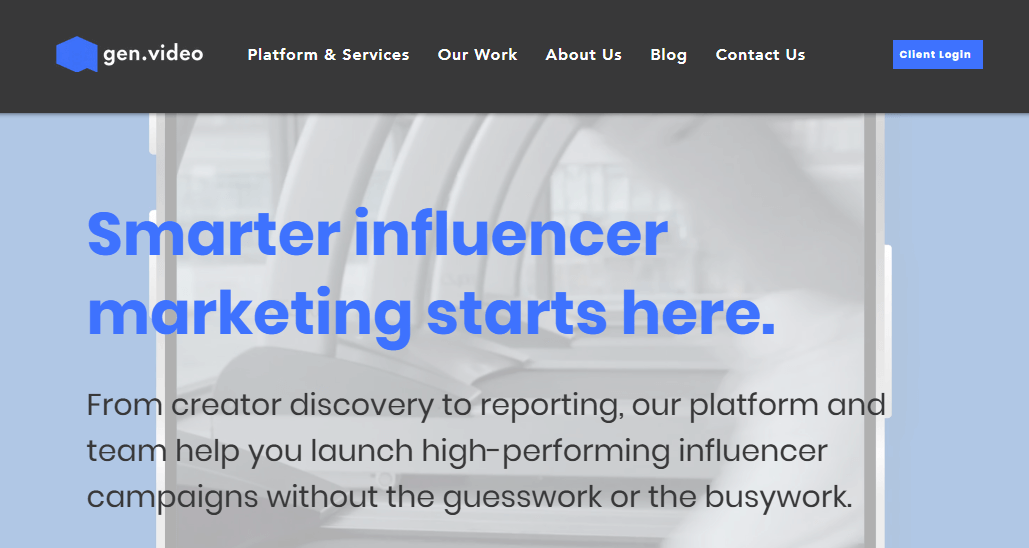
Platform Coverage: Instagram, TikTok, YouTube
Pricing: Custom enterprise-based pricing depending on campaign scope, features, and retailer integrations
Reviews: 4.7/5.0 (G2)
Best For: Brands and agencies selling through major retailers that want video-first creator programs with shoppable content and retail sales attribution (e.g., Amazon, Walmart, Target).
Ease of Use (UX/UI): Modern interface with video timestamping enables collaboration efficiently. Some processes require adaptation for large teams.
Customer Support: Onboarding and client success teams guide through sourcing, approvals, and reporting. Highly responsive support is consistently praised.
Gen.video focuses on Instagram, TikTok, and YouTube with shoppable video content and retail sales attribution, whereas Noxinfluencer supports five major platforms with TikTok Shop integration and influencer analytics. Gen.video prioritizes video-first campaigns and retail-focused performance, while Noxinfluencer offers full campaign management, AI-assisted outreach, and competitor benchmarking.
Pricing for Gen.video is custom enterprise-based depending on features and scope, compared to Noxinfluencer’s Business at $1,499/quarter or $3,899/year, and Enterprise at $7,999/year. Gen.video excels in shoppable content and retail tracking, whereas Noxinfluencer provides scalable influencer discovery, TikTok Shop tools, and AI workflow automation.
Brands emphasizing video commerce and retail-driven campaigns will prefer Gen.video. Noxinfluencer suits teams managing multi-platform campaigns with TikTok Shop and detailed analytics.

Platform Coverage: YouTube, Instagram, TikTok, and other video-focused social platforms
Pricing:
Reviews: 4.0/5.0 (G2)
Best For: D2C brands and retailers looking to increase trust and conversions through video commerce.
Ease of Use (UX/UI): AI-powered video search allows advanced filtering and quick discovery, but teams need time to fully master it. Integration with Shopify and other ecommerce platforms is smooth and reliable.
Customer Support: Email and live chat support for Starter and Growth plans; Enterprise includes phone support and custom onboarding. Teams report fast response times and hands-on assistance for strategy and content execution.
Vyrill focuses on video content discovery, sentiment analysis, and licensing for YouTube, Instagram, and TikTok, while Noxinfluencer emphasizes multi-platform influencer discovery, TikTok Shop tools, and campaign analytics. Vyrill excels in video performance tracking and AI-driven insights, whereas Noxinfluencer supports AI-assisted outreach, competitor monitoring, and large-scale campaign management.
Vyrill pricing starts at $249/month for Starter, $499/month for Growth, and custom for Enterprise, compared to Noxinfluencer’s Business at $1,499/quarter or $3,899/year, and Enterprise at $7,999/year. Vyrill is ideal for brands needing advanced video insights and UGC measurement, whereas Noxinfluencer is better for multi-platform campaigns and TikTok Shop-focused teams.
Teams focused on video commerce and sentiment evaluation will favor Vyrill. Noxinfluencer suits broader influencer campaigns with TikTok Shop integration and AI automation.
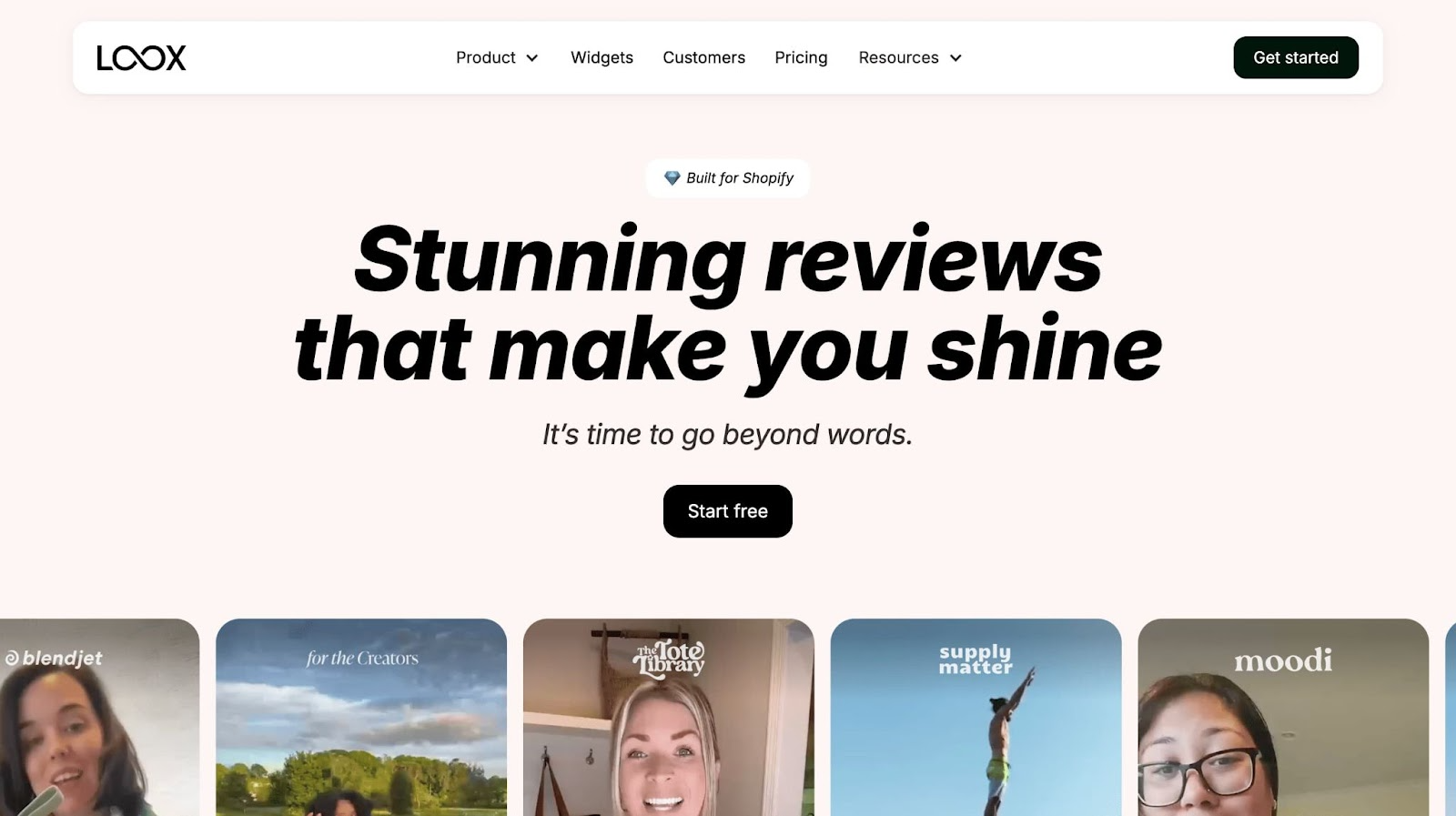
Platform Coverage: Shopify stores with integrations for Google Shopping, Meta Shops, Klaviyo, Omnisend, Shopify Plus
Pricing:
Reviews: 4.9/5.0 (G2)
Best For: Shopify merchants of all sizes looking to showcase photo and video reviews, drive trust with UGC, and boost referrals and upsells.
Ease of Use (UX/UI): Widgets integrate easily into product pages with minimal setup. Mobile lag and customization limits are occasional concerns.
Customer Support: 24/7 email support; some reports of delayed responses or inconsistent quality.
Loox is designed for Shopify stores with integrations for Google Shopping, Meta Shops, Klaviyo, and Omnisend, focusing on visual reviews, referrals, and UGC galleries, while Noxinfluencer supports influencer discovery, TikTok Shop campaigns, and competitor analytics across multiple platforms.
Loox pricing starts at $12.99/month for Beginner, $39.99/month for Scale, and $299.99/month for Unlimited, compared to Noxinfluencer’s Business at $1,499/quarter or $3,899/year, and Enterprise at $7,999/year. Loox is tailored for eCommerce stores needing review collection and referral management, while Noxinfluencer serves multi-platform campaigns with AI tools and TikTok Shop focus.
Brands looking to boost social proof and customer reviews will favor Loox. Noxinfluencer is ideal for teams running influencer campaigns at scale, with TikTok Shop integration and advanced analytics.
When looking for NoxInfluencer alternatives, brands and agencies have a variety of platforms to choose from depending on campaign objectives and budget. Platforms like Modash and Heepsy excel in influencer discovery and audience validation, while tools like GRIN and Captiv8 cater to teams seeking robust campaign management and multi-platform analytics.
Among these options, Influencer Hero stands out as a top choice for influencer marketing measurement. It offers a comprehensive suite of features—including influencer discovery, performance analytics, campaign tracking, content measurement, UGC management, and ROI reporting—providing actionable insights across multiple social platforms.
For brands looking to scale influencer campaigns efficiently and with confidence, Influencer Hero combines depth, automation, and ease of use in one platform. Request a demo today to explore why it’s trusted by marketers aiming for precise, measurable, and scalable influencer marketing results.

Some of the top alternatives to NoxInfluencer include Influencer Hero, Modash, Captiv8, and GRIN. Among these, Influencer Hero stands out as a full all-in-one solution, offering influencer discovery, CRM, outreach automation, analytics, UGC management, gifting, and affiliate payments in a single platform, ideal for brands that want to manage campaigns efficiently without juggling multiple tools.
NoxInfluencer is known for its strong focus on YouTube analytics, but alternatives like Influencer Hero and CreatorIQ offer broader platform coverage, including Instagram, TikTok, Facebook, and Twitter. This makes them more versatile for brands that operate across multiple social media channels. Platforms like Later and Grin also integrate with eCommerce platforms, adding value for online retail brands looking to connect influencer campaigns with sales data.
Yes, several NoxInfluencer alternatives offer agency services in addition to their software platforms. Influencer Hero, Upfluence, and CreatorIQ are notable examples that provide both SaaS solutions and professional agency support. This combination allows brands to choose between managing their influencer campaigns in-house or outsourcing them to experienced professionals.
Influencer Hero stands out as a strong alternative to NoxInfluencer due to its all-encompassing suite of features, including influencer discovery, CRM, automated outreach, detailed analytics, influencer gifting, and affiliate marketing capabilities. Unlike NoxInfluencer, which primarily focuses on analytics, Influencer Hero offers a holistic approach to influencer marketing, catering to both the creative and analytical aspects of campaign management. Its inclusion of both software and agency services provides additional flexibility for users.
The pricing and commitment requirements vary widely among NoxInfluencer alternatives. For instance, Influencer Hero offers a monthly subscription starting from $649, making it accessible for brands with varying budgets and short-term needs. In contrast, platforms like Upfluence and CreatorIQ typically require annual commitments and cater to brands with a higher budget, reflecting their extensive features and professional services. Potential users should consider their budget, the scale of their influencer marketing efforts, and the specific features they need when comparing these platforms.



Schedule a Demo with one of our media experts below.